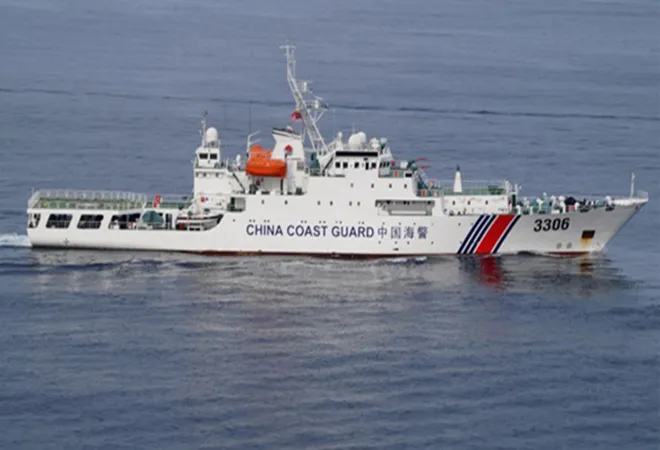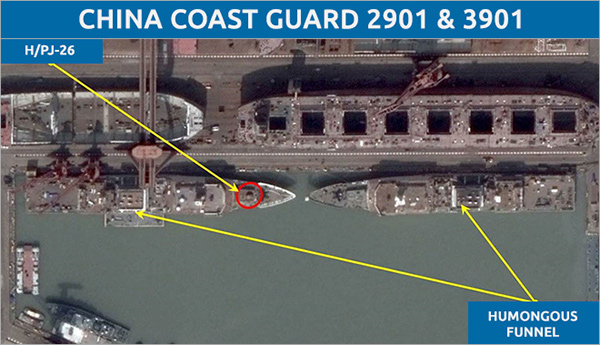
China's recent maritime disputes have mostly been in the East China Sea (ECS) and the South China Sea (SCS). The huge reclamations, creating monsters of islands in the middle of the ocean, need to be guarded all the time. China needs to guard the seas around those islands to maintain control. Sending warships to show flag generally considered as inflammatory hence most countries have coast guard doing the policing rather than naval ships. China has to compete with Japanese Coast Guard (JCG) around Diaoyutai and US Coast Guard (USCG) in SCS.
China has decided to overcome this challenge by producing three distinct and new types of patrol ships for its coast guard. Google Earth imagery in March 2015 was used to study the pattern of CCG ships construction.
CCG 2901
During earlier face offs with JCG, China faced acute imbalance between the two coast guards' ships. China did not have anything to pit against JCG Shikishima class cutters with 9,300 tonne displacement.
China's Jiangnan Changxing (JNCX) shipyard has produced two 12,000 tonne cutters for the CCG. These are considered the largest CG ships in the world. They are heavier than US Navy's Ticonderoga class guided missile cruisers. The Chinese type has not yet been revealed. The ship with 164m length and 21.5m beam can clock speeds over 35knots. It is lightly armed with an H/PJ-26 gun on the bow.

Some Chinese experts believe that these ships can easily be converted to troop carrying vessels like landing platform dock (LPD). But that would need a large amount of modification work along with major weapons systems in reserve that may not be available during emergencies.
Type 818
The Type 818 was first contracted for by the Sea Police, but now are being commissioned into the CCG. Three ships are seen in different stages of construction at Guangzhou Huangpu (GZHP) shipyard. The design is considered to be based on Type 54A frigates of the PLAN. These ships are armed with one H/PJ-26 on the bow and two H/PJ-13 guns on the superstructure and on top of the hangar.

Comparison of Type 818 and Type 54A, although similar in length, reveals that bow of Type 818 is more sleek which would provide for a higher speed. The displacement is considered similar approximately 3,000 tonnes.

Type 718
The Type 718 ships are smaller in size and considered to be based on the design of Type 56 corvettes. Comparison of the two reveals that Type 718 ships are much larger by almost 10m and wider by more than 2m. The ship is known to displace between 1,500 to 2,000 tonnes. The bow again is sleek providing for higher speeds.

Two of these ships have been constructed at GZHP and four more are observed at different stages of construction at Wuchang. These ships also are armed with a single H/PJ-26 on the bow.


Implications
With the advent of these three new types of ships in CCG, the sea policing and maritime capabilities get a quantum boost. The speeds of 35 knots with sheer tonnage would give these ships greater advantage over competing nations' ships in ECS and SCS.
A nasty turn by 2901 or 3901 in front of any US Navy ship will bring the entire US armada to a grinding halt in the SCS. Tackling an unarmed vessel behaving erratically is very difficult, especially for a heavily armed ship.
Although conversions of these coast guard ships to warships may not be an effective strategy, they certainly can be used to ferry troops in emergencies.
The US, Japan and other countries in the ECS and SCS need to bolster their coast guard presence to counter this challenge.
The views expressed above belong to the author(s). ORF research and analyses now available on Telegram! Click here to access our curated content — blogs, longforms and interviews.



 China's recent maritime disputes have mostly been in the East China Sea (ECS) and the South China Sea (SCS). The huge reclamations, creating monsters of islands in the middle of the ocean, need to be guarded all the time. China needs to guard the seas around those islands to maintain control. Sending warships to show flag generally considered as inflammatory hence most countries have coast guard doing the policing rather than naval ships. China has to compete with Japanese Coast Guard (JCG) around Diaoyutai and US Coast Guard (USCG) in SCS.
China has decided to overcome this challenge by producing three distinct and new types of patrol ships for its coast guard. Google Earth imagery in March 2015 was used to study the pattern of CCG ships construction.
China's recent maritime disputes have mostly been in the East China Sea (ECS) and the South China Sea (SCS). The huge reclamations, creating monsters of islands in the middle of the ocean, need to be guarded all the time. China needs to guard the seas around those islands to maintain control. Sending warships to show flag generally considered as inflammatory hence most countries have coast guard doing the policing rather than naval ships. China has to compete with Japanese Coast Guard (JCG) around Diaoyutai and US Coast Guard (USCG) in SCS.
China has decided to overcome this challenge by producing three distinct and new types of patrol ships for its coast guard. Google Earth imagery in March 2015 was used to study the pattern of CCG ships construction.
 Some Chinese experts believe that these ships can easily be converted to troop carrying vessels like landing platform dock (LPD). But that would need a large amount of modification work along with major weapons systems in reserve that may not be available during emergencies.
Some Chinese experts believe that these ships can easily be converted to troop carrying vessels like landing platform dock (LPD). But that would need a large amount of modification work along with major weapons systems in reserve that may not be available during emergencies.
 Comparison of Type 818 and Type 54A, although similar in length, reveals that bow of Type 818 is more sleek which would provide for a higher speed. The displacement is considered similar approximately 3,000 tonnes.
Comparison of Type 818 and Type 54A, although similar in length, reveals that bow of Type 818 is more sleek which would provide for a higher speed. The displacement is considered similar approximately 3,000 tonnes.

 Two of these ships have been constructed at GZHP and four more are observed at different stages of construction at Wuchang. These ships also are armed with a single H/PJ-26 on the bow.
Two of these ships have been constructed at GZHP and four more are observed at different stages of construction at Wuchang. These ships also are armed with a single H/PJ-26 on the bow.


 PREV
PREV


